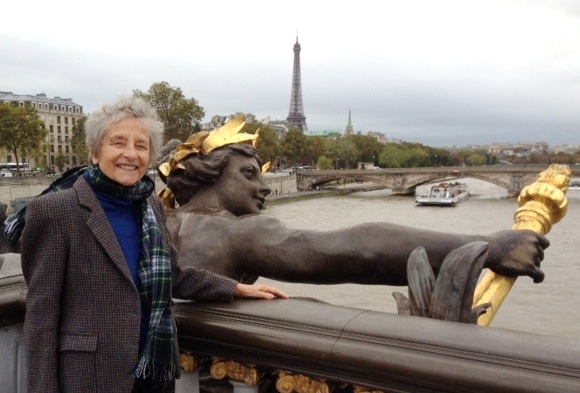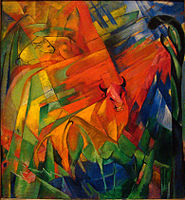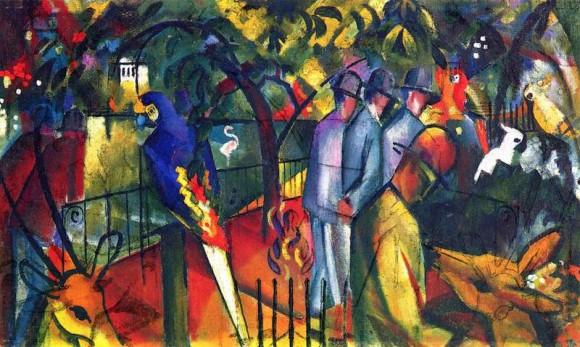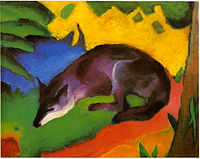
The promise of two young men to become among the most important German artists of the 20th century was cut short when Franz Marc (1880-1916) and August Macke (1887-1914) were both killed on the front at the outset of World War I.

The Lenbachhaus museum of Munich, built at the turn of the (20th) century when Munich was the capital of German art, will hold an exhibit in May entitled. “Two Friends.” It shows how Marc and Macke met in 1910, discovered their mutual works with enthusiasm and struck a friendship, which was to last until their death.
The eve of the “Great War” was a time of artistic explosion, not limited to the Impressionists, Cézanne and other great French masters. All of Europe, including the Russian giants like Malevich, or Tatlin, was set ablaze and the German schools of painting played an important role in the cross-pollinization of the art movements.
In 1905 Ernest Ludwig Kirchner (1880-1938) founded Die Brucke (the bridge) in Dresden. The human figures he painted are very distinctive with an angular and depraved look. The Nazis called him “degenerate.” Die Brucke was part of a larger German Expressionist movement based at the Sturm gallery in Berlin and characterized by the rejection of any form of academism, the acerbic satire of the bourgeois decadence, and the crude, almost perverted, representation of the bohemian life the artists led in their studios.
In 1909, Wassily Kandisky (1866-1944) wanted to distance himself from the Neue Künstlervereinigung München (NKVM — the Munich New Artist’s Association) painters and settled in Murnau, a small village on the edge of Bavarian Alps with a group of artists including his companion Gabriele Munter and Alexej Jawlensky. For Marc and Macke, it was a pivotal moment to meet them there.
Even before knowing each other, Marc and Macke had shared a love for painting animals, particularly cats. Both were fascinated by the artistic developments taking place in France. In 1907, and again in 1908 Macke was in Paris and visited the galleries of Bernheim-Jeune, Ambroise Vollard and Durand Rueil, to see Pissaro, Monet, Dégas, Renoir and Seurat. Marc travelled several times to France from 1903 onwards, spending long hours at the Louvre, where he was particularly attracted to Van Gogh’s paintings.

August Macke’s city scenes showed silhouettes of slim and elegant women, admiring the latest fashion at shop windows and a sophisticated urban population sitting at cafes or strolling leisurely in a park. Macke looked for harmony in humans and in nature. His colors were vibrant and the atmosphere serene in sharp contrast with the violent, even depressive paintings of the Expressionists like Otto Dix, George Grosz or Max Beckman.

Before becoming an artist, Marc had thought of becoming a theologian. In 1909, he left Munich for the wilderness of Bavarian Alps to paint animals and eventually moved closer to Murnau. He sought the essence and the purity of animal through a theosophical view of the cosmos. Instead of being naturalistic, his representation of deers or tigers was increasingly stylized. The young wild horses seemed to bask in their freedom. In 1911 Wassily Kandisky and Marc created Der Blaue Reiter (The Blue Rider) group, named after the themes of horses and cavaliers found in their paintings.
At a time when the abstraction was like a tidal wave – Picasso and Braque in France, Paul Klee in Switzerland, or Mikhail Larionov in Russia – it is not surprising that Marc and Macke were drawn to these new forms. Robert Delaunay and Italian Futurist Gino Severini became their inspiration.
But sadly this was to be a brief adventure, since both artists were killed prematurely in the war.

About the author: Nicole Prévost Logan divides her time between Essex and Paris, spending summers in the former and winters in the latter. She writes a regular column for us from her Paris home where her topics will include politics, economy, social unrest — mostly in France — but also in other European countries. She also covers a variety of art exhibits and the performing arts in Europe. Logan is the author of ‘Forever on the Road: A Franco-American Family’s Thirty Years in the Foreign Service,’ an autobiography of her life as the wife of an overseas diplomat, who lived in 10 foreign countries on three continents. Her experiences during her foreign service life included being in Lebanon when civil war erupted, excavating a medieval city in Moscow and spending a week under house arrest in Guinea.